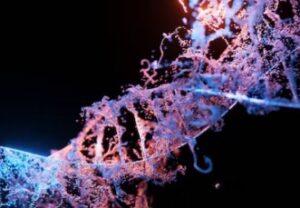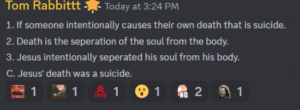Because the term “evolution” can be used in more than one way, and conversations on Darwin’s theory can be confused by moving back and forth between more than one definition of the word, many people find it helpful to make a distinction between “microevolution” (small changes within a particular kind of organism) and macroevolution (large changes required to move from one type of organism to another). A critic of Darwinism, for example, will often want to clarify that they agree that small-scale changes occur quite often within a given type of organism, but such changes have limits and can’t build on one another in the kind of way that would lead to the emergence of an entirely new type of organism. Such an individual may express this by saying, “I believe in microevolution, but not macroevolution.” These categories can be helpful in keeping conversations focused on the right issues or as a starting point in discussing the limits of mechanisms like random mutation and natural selection.
Defining Terms
Darwinian biologist Theodosius Dobzhansky introduced the terminology of “microevolution” and “macroevolution” into English in his 1937 work “Genetics and the Origins of Species.” Since then, this terminology has become commonplace in distinguishing between the kind of small changes that we clearly observe within populations of the same basic type of organism and the larger, more fundamental transformations required by Darwinian evolution (which, Darwinists would argue, take far too long for us to observe directly).
Microevolution refers to changes within a precise category of animals, like a wild dog gradually shifting over many generations to beagles, pugs, or poodles, or like an early wild cat eventually siring a lion in one environment or a housecat in another. Macroevolution, on the other hand, would be the kind of change needed to produce one category or organism from another, like amphibians giving rise to reptiles or reptiles to birds.1
Thus, microevolution is the kind of ordinary change that everyone agrees occurs within populations of living things. It is uncontroversial. Shepherds, farmers, dog breeders, and all kinds of other ordinary men and women have known about and depended on this kind of change for all of human history. People actively used such changeability in plants and animals to shape our crops, livestock, and other domesticated plants and animals, and it self-evidently occurs in nature as well. Mechanisms like natural selection acting on ordinary variation are certainly capable of bringing about this scale of change.
Macroevolution is another matter entirely. As Dr. Robert P. Waltzer explains:
“Macroevolution, in contrast, means evolutionary change that produces fundamentally new biological structures and forms of life. At some point in the history of life there were no bird wings. And then eventually there were. If evolutionary processes invented bird wings, that’s macroevolution.”2
While microevolution is readily accepted by pretty much everyone, macroevolution is at the center of most of the debates related to Darwinism.
Macroevolution and Conversational Focus
Thus, when critics of Darwinism specify that they reject macroevolution and not microevolution, they are pointing out that, while everyone agrees that certain limited changes happen within particular body types or groups of organisms, the area of debate is whether or not one basic category of plant, animal, fungus, or microbe can develop into an entirely different category or can acquire novel structures or systems that redefine what sort of organism they are.
 And this is one of the most basic and most helpful uses of these terms. They help to focus the conversation. When someone says vaguely that they don’t believe in “evolution,” the Darwinist will often point to any example of even the smallest change in an organism and honestly believe they have made a solid point. The two people are talking past each other because they mean different things by the same word. But, when one clarifies that it is specifically macroevolution that is at issue, this provides a bit more clarity. Things like the change of the shape of a finch’s beak or the development of antibiotic resistance in a certain bacterium do not constitute macroevolution. The finch is still very much a finch and the bacterium is still the same basic kind of bacterium. These examples are virtually irrelevant because they represent the kind of changes on which both sides already agree!
And this is one of the most basic and most helpful uses of these terms. They help to focus the conversation. When someone says vaguely that they don’t believe in “evolution,” the Darwinist will often point to any example of even the smallest change in an organism and honestly believe they have made a solid point. The two people are talking past each other because they mean different things by the same word. But, when one clarifies that it is specifically macroevolution that is at issue, this provides a bit more clarity. Things like the change of the shape of a finch’s beak or the development of antibiotic resistance in a certain bacterium do not constitute macroevolution. The finch is still very much a finch and the bacterium is still the same basic kind of bacterium. These examples are virtually irrelevant because they represent the kind of changes on which both sides already agree!
Thus, by focusing the conversation specifically on macroevolution, one may reduce the misunderstandings and at least partially help to keep the conversation on a fruitful track.
Just microevolution over time?
Of course, one common objection the Darwinist will raise is that there isn’t really a fundamental difference between micro and macroevolution. After all, the “big” changes we’re talking about are really just the sum total of many, many small changes occurring over a vast period of time. If microevolution is true, and it goes on for literally millions or billions of years, wouldn’t that add up to some pretty radical changes, even leading to the rise of wholly different sorts of organisms?
 The first and most simple answer is that our experience tells us otherwise. A dog’s snout can change over time in a variety of ways: becoming shorter or longer, wider or narrower. Its fur can alter its color, length, thickness, texture, or even virtually disappear leaving mostly bald skin. Its tail can grow longer, thinner, thicker, bushier, or become short and curled. Its legs can become long, broad, short, or stubby; its paws can change shape to fit a variety of terrains. Its body may become elongated like a dachshund, slim like a greyhound, or broad and short like an English bulldog. And yet, none of these changes touches the fundamental “dog” structure. No version of the snout is a step toward something other than a snout. No shape of the paw deviates even slightly from the definition of a paw. All kinds of variation are possible, but only within the essential confines of “dogness.” None of the innumerable variations we see within dogs are the kinds of changes that could ever “add up” to something fundamentally non-dog, no matter how many such changes occur. One might joke that a chihuahua or a poodle is not a “real dog,” but this is a playful jest. They have certainly strayed far from their wolflike ancestors, but not so far as to become something else.
The first and most simple answer is that our experience tells us otherwise. A dog’s snout can change over time in a variety of ways: becoming shorter or longer, wider or narrower. Its fur can alter its color, length, thickness, texture, or even virtually disappear leaving mostly bald skin. Its tail can grow longer, thinner, thicker, bushier, or become short and curled. Its legs can become long, broad, short, or stubby; its paws can change shape to fit a variety of terrains. Its body may become elongated like a dachshund, slim like a greyhound, or broad and short like an English bulldog. And yet, none of these changes touches the fundamental “dog” structure. No version of the snout is a step toward something other than a snout. No shape of the paw deviates even slightly from the definition of a paw. All kinds of variation are possible, but only within the essential confines of “dogness.” None of the innumerable variations we see within dogs are the kinds of changes that could ever “add up” to something fundamentally non-dog, no matter how many such changes occur. One might joke that a chihuahua or a poodle is not a “real dog,” but this is a playful jest. They have certainly strayed far from their wolflike ancestors, but not so far as to become something else.
Human breeders and natural selection have the same wall. They are limited by the kinds of variation that actually occur. They can only choose among what variants actually arise. And those changes seem to be bound within the fundamental limits of dogness, catness, finchness, etc.
Why natural selection can only produce microevolution
This is not a mere assumption. Natural selection is, by its very nature, a fundamentally self-limiting process. The way it works will always avoid building complicated new structures or systems beyond a very small and narrow point. As Dr. Michael Behe puts it:
“Darwinian evolution is self-limiting – the same factors that make it work well on a small scale ensure that it doesn’t go very far”3
Darwinian evolution is driven by natural selection acting on random variation. Unplanned, spontaneous genetic mutations occur which cause relatively minor variations within a given species or category of organism. If these variations are harmful in a given environment (which they typically are), they die and/or fail to reproduce and so that variation quickly ceases to exist. If they provide a benefit, they will succeed and reproduce and, over time, there will be more and more of them. This is how microevolution occurs, and the basic process is uncontroversial.
However, the above description is a bit oversimplified. Variations don’t get in line and try out one at a time in an organized manner. Many variations may occur in different members of the same species at the same time and in the same place. Thus, each variant is not only competing with the already established “ordinary” form of the organism, but also with all the other variants. A mutation that provides a small benefit may still lose out to another variation that provides a much greater immediate benefit.
 What’s more, it is vital to note that “beneficial” is not the same thing as constructive or developmental. In other words, a mutation might help the organism by damaging or discarding a current structure rather than adding some new structure. Indeed, the vast majority of beneficial mutations are of this sort! And this makes sense. These mutations are random. They are not systematically trying to solve the problems posed by a given environment. And small, random changes are far more likely to break something than they are to build something that is new, functional, and useful. Yet, breaking a system or even outright ditching a structure entirely is not necessarily a bad thing, especially as an unplanned, short-term strategy. If you’re on a ship caught in a storm at sea and you’re starting to take on water, ditching the cargo to lighten the ship is much easier and likely far more effective than trying to respond to that imminently deadly environment by building a new and better system for floatation and buoyancy. This is especially true if you have no engineering knowledge whatsoever and would have to build the new system through small, random acts of unplanned tinkering.
What’s more, it is vital to note that “beneficial” is not the same thing as constructive or developmental. In other words, a mutation might help the organism by damaging or discarding a current structure rather than adding some new structure. Indeed, the vast majority of beneficial mutations are of this sort! And this makes sense. These mutations are random. They are not systematically trying to solve the problems posed by a given environment. And small, random changes are far more likely to break something than they are to build something that is new, functional, and useful. Yet, breaking a system or even outright ditching a structure entirely is not necessarily a bad thing, especially as an unplanned, short-term strategy. If you’re on a ship caught in a storm at sea and you’re starting to take on water, ditching the cargo to lighten the ship is much easier and likely far more effective than trying to respond to that imminently deadly environment by building a new and better system for floatation and buoyancy. This is especially true if you have no engineering knowledge whatsoever and would have to build the new system through small, random acts of unplanned tinkering.
Because of this, variations that break or discard a system or structure will almost always win out in the natural selection game. This is true even when such variations may possibly be harmful in the long run. And mutations of this sort are certainly not plausible steps to developing a newer and more complex category of organism, As an immediate response to a current challenge (which is the only thing relevant to blind, natural selection) the breaking option is faster, more efficient, and typically more effective than trying to build something new through small, random increments (each of which would have to not only be beneficial but would have to consistently win out against rival beneficial breaking options.)
Yet another factor is that, since there are far more ways to break a system than to build one, there will always be far more variations involving broken or deleted systems than there are variations involving anything that could remotely be called building. This means that for any one constructive mutation there will always be many destructive-yet-beneficial varieties for it to compete with. And at every step, one or more of the destructive versions will always be more likely to provide the greatest immediate benefit. As Behe again puts it:
“it’s not so much the rarity of constructive mutations that undermines Darwinian evolution – it’s the frequency of damaging but helpful ones. Degradative but adaptive…mutations appear quickly even on short time scales, even in small populations. They don’t need large numbers or long times to occur. Thus they will always be present everywhere in life much more quickly and in far greater numbers than constructive…mutations. Damaging yet beneficial mutations will rapidly be selected when nothing else is available and compete fiercely with any [constructive] mutations that might eventually arrive on the scene.”4
Thus, purely unplanned processes like natural selection acting on random mutation will, in the long run, always ultimately favor simplifying the existing organism rather than building a new design for a fundamentally different organism. These processes are great at rapidly responding to new environments the same way sailors are great at responding to a sudden storm. In both cases, they quickly identify which things can be ditched in order to stay alive amidst the new challenges. It is a useful and life-saving approach, but it is never going to build complex new systems.
Conclusion
Critics of Darwinian evolution do not question all forms of biological change. They agree with microevolution, that certain kinds of small but sometimes helpful changes occur within a given type of organism. What they deny is macroevolution, or the assertion that blind, natural processes are sufficient to (even cumulatively over a very long period of time) produce new and wholly different kinds of organisms. Not only is microevolution the only kind of biological change that has ever been observed, but also, and far more importantly, the very nature of natural selection acting on random mutation ensures that it will not produce the kind of radically and complexly constructive results that macroevolution demands. Thus, it is wholly rational to accept microevolution while rejecting the idea that such small changes would ever add up to a transition from one type of organism to another.
References
| 1↑ | A. E. Wilder, The Scientific Alternative to NeoDarwinian Evolution (TWFT Publishers, 1987) x |
|---|---|
| 2↑ | Thomas Y. Lo, Paul K. Chien, Eric H. Anderson, Robert A. Alston, Robert P. Waltzer, Evolution and Intelligent Design in a Nutshell (Discovery Institute, 2020) 91 |
| 3↑ | Michael Behe, Darwin Devolves (HarperOne, 2019) 172 |
| 4↑ | Michael Behe, Darwin Devolves (HarperOne, 2019) 186 |






